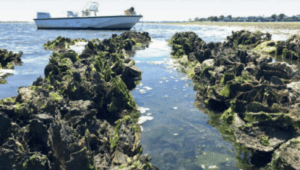 Long Island’s history and culture are so connected to its shellfish that the first people to live on New York’s coast called it the “Island of Shells”. Jutting into the Atlantic from New York Harbor, the island draws residents and visitors alike to its beaches, fishing and famously good clams and oysters. Equally famous, however, is the impact six years ago of Hurricane Sandy, which caused billions of dollars’ worth of damage across the Eastern Seaboard. Part of the problem was the gradual disappearance of the wetlands that used to defend the island from storm surges caused by hurricanes. Now, a new project has been set up that aims to strengthen and renew this natural protective barrier. “The marshland has been degrading to a point at which this part of Long Island is very vulnerable,” says Hempstead Town Supervisor Laura Gillen, who launched a “living shores” project this summer in collaboration with local environmentalists. They’re using thousands of discarded shells from restaurants around Long Beach – and from this month’s Oyster Festival at aptly named Oyster Bay – to protect a small barrier island from further erosion. This in turn will protect densely populated areas and major roads from flooding. “With this living reef project, we are dramatically improving coastal resiliency,” says Gillen.
Long Island’s history and culture are so connected to its shellfish that the first people to live on New York’s coast called it the “Island of Shells”. Jutting into the Atlantic from New York Harbor, the island draws residents and visitors alike to its beaches, fishing and famously good clams and oysters. Equally famous, however, is the impact six years ago of Hurricane Sandy, which caused billions of dollars’ worth of damage across the Eastern Seaboard. Part of the problem was the gradual disappearance of the wetlands that used to defend the island from storm surges caused by hurricanes. Now, a new project has been set up that aims to strengthen and renew this natural protective barrier. “The marshland has been degrading to a point at which this part of Long Island is very vulnerable,” says Hempstead Town Supervisor Laura Gillen, who launched a “living shores” project this summer in collaboration with local environmentalists. They’re using thousands of discarded shells from restaurants around Long Beach – and from this month’s Oyster Festival at aptly named Oyster Bay – to protect a small barrier island from further erosion. This in turn will protect densely populated areas and major roads from flooding. “With this living reef project, we are dramatically improving coastal resiliency,” says Gillen.
Work started this July, when volunteers and council workers helped to pack tens of thousands of discarded shells (collected from a dozen or so restaurants over the course of two years) into mesh bags, and submerged them in the waterway. Experts from the town’s Department of Conservation and Waterways will then place oyster and clam seedlings onto the shucked shells in the mesh bags to mature. “As the oysters grow, the reef expands and provides a habitat for other marine life,” explains Fricchione. Each oyster can filter about 200 litres of seawater a day, so they’ll help clean up years of pollution that contributed to the coastal erosion in the first place. Since the project took off, many more restaurants have been applying to join in. “They see it as win-win,” says Michael Fricchione, Hempstead Town’s press secretary, “because they can get rid of their discarded shells without them going into landfill, and the town picks them up for free so they don’t have to worry about transporting them.” The hope is that, over time, the living reef will integrate with existing islands and eventually give a mile’s worth of coastal protection – as well as more oysters for restaurants and festivals for years to come.
Written by Celia Woolfrey Celia Woolfrey.


